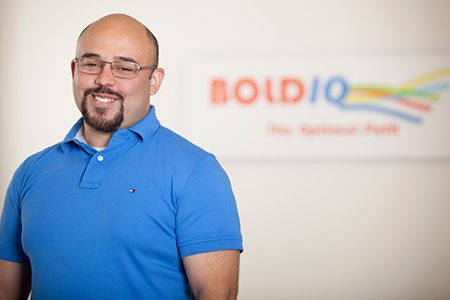October 7, 2016
In
Company News
At a crowded WTIA 2016 FullConTech conference, in front of over 300 people, BoldIQ support engineer – Daniel Browning – gave a presentation that was identified by WTIA as one of the standout moments of the entire event. Read the transcript below and see why he got a standing ovation:
Thank you ladies and gentlemen for your time. I would like to express my dearest gratitude to the people that helped me to get where I am today:
- My wife and daughter
- Fellow service men and women of the past and present
- Roei Ganzarski, Christer Lundin and the entire BoldIQ Family
- Julie Pham and everyone at the Washington Technology Industry Association.
A little over eight years ago, as a recent high school graduate, I made the decision to become the next generation in our family to serve our country. Like most recruits I was excited joining a lifelong brotherhood, seeing the world and having the honor to standup for what I believe in. I knew joining the military in a time of war was different from joining in a time of peace. I also knew that the military may not be a lifelong commitment and therefore I had three requests for Uncle Sam. First, I was in great need of having somebody in my life helping me to become more focused, disciplined and goal oriented. 12 weeks of boot camp and highly dedicated drill sergeants fixed that really quickly. Secondly, I wanted the military to train me and provide me the skills that would allow me to survive beyond the battle fields of Iraq and Afghanistan. And in the end, I wanted the experience to show me the world and help me to walk through doors that I did not imagine were open for me.
After serving for almost six years as a signal communication specialist, I left the service as a disabled war veteran because my last tour to Afghanistan did not end as I hoped for. At that time, I was on a fast track and wanted to serve for 20 plus years until I was qualified to retire. But when that did not work out as planned I had to evaluate my choices. I did not want a job, but a career, I did not want to pursue the often desired path by veterans to work for the government and I wanted to stay in the field the Army trained me in. I therefore assessed my fears, possibilities, my goals and how to get what I wanted. First thing I realized as a soldier and soon to be veteran was that there are stereotypes about veterans and civilians that I couldn’t allow to get in my way. I remember watching the movie major Payne where the main character gets arrested and blames civilian life for it, referring to it as “civilian puke’s existence”. The first thing that came to my mind was, that cannot be me. So I grew a goatee, gained a few pounds, minimized my excessive military courtesy, minimized yelling and cursing, and above all I did not expect the world to owe my everything or anything. Because I met better men and women in and out of the service.
On the other hand, I was and still am, to a certain extent, fearful of certain questions and stereotypes about my military past, such as questions about my war experiences and political views, the general misconception of the military, and of course my struggle to realize that I don’t have to work 16-20 hours a day. Therefore, I would like to challenge everyone in this room, employer, educator, hiring recruiter, policy maker and any member of the civilian and military community, to picture in your minds, right now, what soldiers and veterans like me look like. And if you’re picturing a bunch of people screaming at each other, more than kicking in doors and going after bad guys on the battle fields, what I encourage you to let go of that picture. Because the military – and the people in it – are so much more. I’m not a violent, gun tooting, super conservative fanatic who believes there is only one right way-my way.
It takes a serious logistical and business apparatus to fulfill the military and this country’s needs and goals. Let me tell you what my life as a soldier looked like:
- I was in charge of IT and military matters to fulfill the needs of up to 400 people.
- 80 people were under my direct command and relied on my technical, human and military leadership skills.
The big question for me was: How can I profit from my experience and background, and most importantly, how can I help employers profit from my background and experience as a veteran.
To the military and veteran community, I can say that I have learned that the best way to overcome the many fears and misconceptions is to be honest and respectful. If someone asks how I feel about the current issues our society faces, I share my views honestly and respectfully, and I respect the views of others, no matter how much they differ from mine. Furthermore, I also tell veterans to consider your options for becoming a civilian tech worker. For me there were two options, Option A) was to obtain certificates and option B) was to get a tech degree. I chose to take advantage of my veteran education benefits, continue my education, and graduate with a degree in computer science. This was a big bet with some risk – because as a 30-year-old non-traditional student, there were people dependent on me, my wife and a newborn child. I needed to figure out the hiring landscape and get a job right after graduation.
But this wasn’t easy. Even in a field that has an average job growth rate between 10 and 27 percent, in an area that I refer to as the IT capitol of the world. It was difficult as a recent college grad who does not write and analyze code every day to successfully pass code skills test. It felt uncomfortable to be interviewed about my past by people who live in an area and work in a field that is considered to be heavily liberal and pacifistic. On top of that, the many miserable circumstances that many veterans face have always been a constant fear and reminder that failing is not an option. The fear of becoming a statistic, of becoming a homeless veteran, standing with a sign on the road asking for help or even worst, becoming one of the 22 veterans per day, who take their own lives. However, there are job and skills advantage of being a veteran that are often underestimated. We are very familiar with making critical decisions in stressful situations, we take everything serious and expect the best qualitative outcome of our work, we obtained leadership skills in probably the most diverse and challenging work environment, and we are always motivated and have a no quite attitude. Nevertheless, the problem is finding a way to close the disconnect between us and the technology world.
For me, the game changer was the Washington Technology Association and draft day. The Washington Technology Industry Association not only provided me with an insight on how to sell my soft skills and tech skills. But they also introduced me to companies that I did not know existed. They provided a college graduate with a nontraditional background a fair chance in a high demanding fast pacing field. After draft day the Washington Technology Industry Association introduced me to BoldIQ. A company that any nontraditional applicant could wish for. An employer willing to teach, provide guidance, training and an exciting workplace with great people to call colleagues and friends. BoldIQ is a scheduling software company that provides organizations the technology to operate at greater capacity. In essence that was exactly what I did in the military. Maybe in a different way, but I helped other soldiers through technology services to operate at a greater capacity, including assuring they come home alive and in one piece. So there can and is always a connection. BoldIQ has been proving to me that it is beneficial for companies to invest in tech rookies. Companies should be willing to train, teach, guide their employees and allow them to make mistakes. Because little did I know that after the service I can once again find an employer who I am loyal to, enjoy working for selflessly and to contribute to a team effort that aims to provide the best possible outcome.
An African proverb says if you want to go fast, go alone. If you want to go far, go together. Technology is a fast-moving industry, and I know that companies feel a sense of urgency when they are hiring new employees, and they want to find people who can do exactly what they need today. But we need to keep in mind that veterans carry experience – like managing people, working under stress, staying focused on the mission – that might not be exactly what you need today but will deliver more and more value over time and continue to make a difference as they grow with your organizations.
Let us not go fast and fail because we did not see and look at the greater picture. But let us go together, as far as possible. So we can improve and positively impact our communities and the whole world by seeking the help and effort of everybody that has a true passion for technology.
Click here to read the WTIA review










